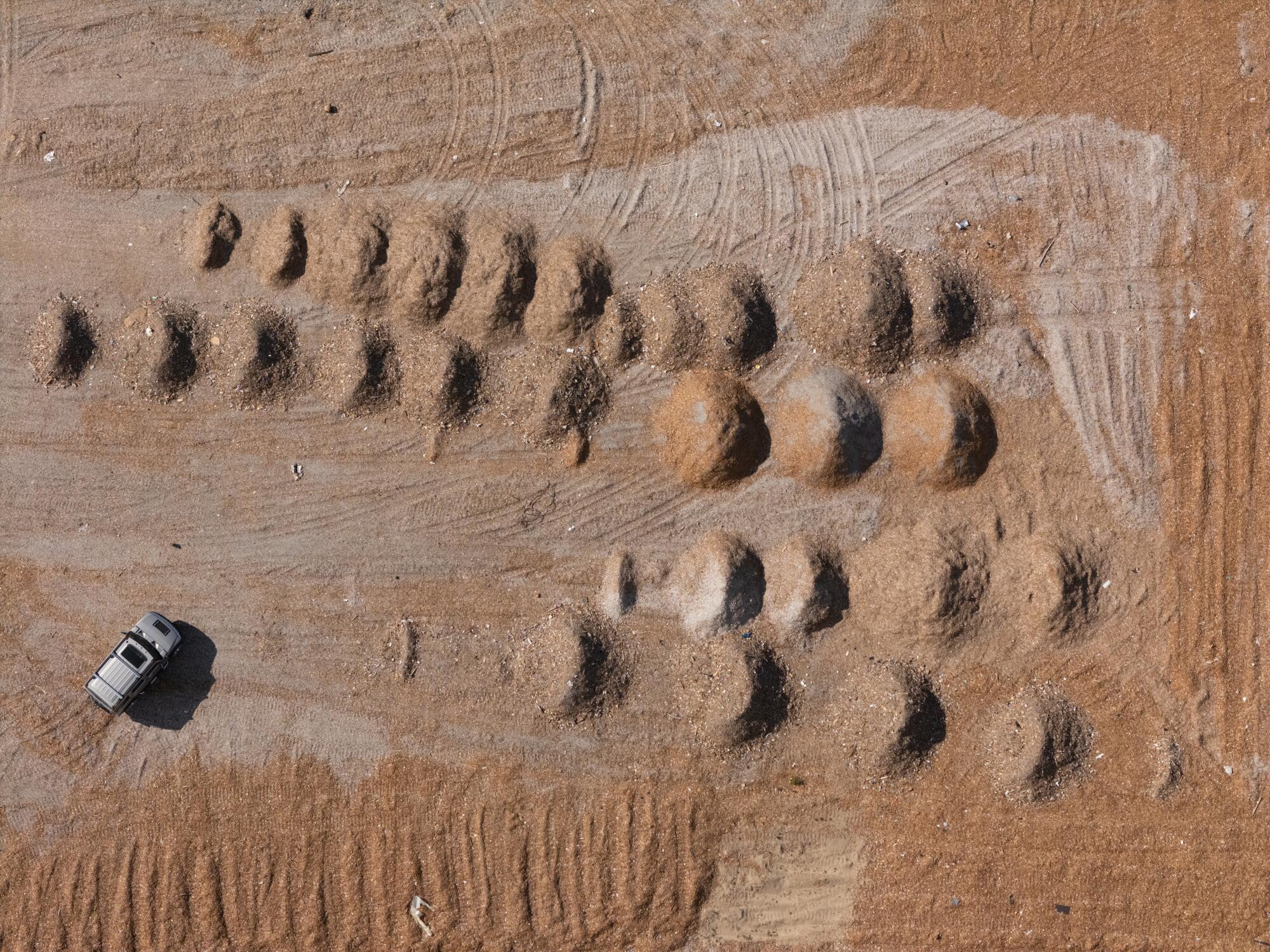
- Share via
- Antelope Valley residents have filed suits in state and federal courts to block what they say is a deluge of unauthorized dumping in remote areas.
- “It’s the Wild West out here,” one property owner said of the dumping occurring in the region.
- Two waste companies denied unlawful dumping, with one saying state law allows compostable material to be disposed on farmland and other properties for beneficial use.
Eric Eller likes to ride his dirt bikes through the canyons, dry riverbeds and rocky outcroppings of the Antelope Valley in the high desert north of Los Angeles.
Eller’s an off-the-grid kind of guy with a “Mad Max” vibe — living in a house on a remote plot of land next to a jury-rigged trailer where he tinkers with the remnants and pieces of gutted automobiles, motorcycles and other mechanical debris.
But Eller’s isolation was obliterated last June when dozens of big dump trucks began snaking up the dirt road behind his house and discarding their loads into the nearby dry river canyon. The caravan of waste-haulers continued in the days that followed, often arriving after sundown or in the dark hours before dawn.
Two months later, the convoys abruptly stopped. But not before the makeshift dump’s surface had been camouflaged with dirt and mulch — much of which has since blown away, revealing a 30-foot-deep noxious stew of chopped-up concrete, plastic tampon applicators, faded plastic children’s toys, toothbrushes, syringes, empty caulking tubes, two-by-fours, faded books, weathered Styrofoam pipe insulation, plastic bucket tops and more.

Across the Antelope Valley, waste trucks are hauling garbage in from the Greater Los Angeles area and Central Valley towns such as Bakersfield, and then dumping it at makeshift sites. Letters, bills and envelopes visible at several of these waste sites in April showed addresses in Pacoima, Los Angeles and Van Nuys, among other cities.
“Illegal dumping has been a problem in the Antelope Valley for decades,” said Chuck Bostwick, a senior field deputy for Los Angeles County Supervisor Kathryn Barger, who represents much of the area. “But it’s gotten worse in the last two or three years, markedly worse.”
In some cases, such as the site behind Eller’s home, the waste sites are flat-out unauthorized. No landowner has given permission to dump at the site, and the waste consists of construction, household and medical debris.
But in others cases, the waste-haulers have the landowners’ permission to dump — but are disposing waste that should be going to landfills equipped to handle household and industrial waste, lawsuits claim.
In one lawsuit filed in U.S. District Court in Los Angeles, residents claim that major residential waste-hauling companies including Athens Services, California Waste Services and Universal Waste Systems are dumping hazardous substances without authorization.
The suit claims these companies are disguising the construction and demolition debris as “green waste by unlawfully covering this waste with highly flammable wood chips and other organic waste.”
Eric Casper, the president of California Waste Services, said in an email that his company has “never engaged in dumping waste of any kind, at any time, in the Antelope Valley — legal or illegal. Nor anywhere else.”

Athens Services also denied any illegal dumping, saying in a statement that California’s organics recycling law “encourages sending compostable material to third parties such as farmers and other property owners for beneficial use. This is the material that Athens Services produces and distributes.”
Universal Waste Systems and other companies named in the suit didn’t respond to requests for comment, nor have they filed responses to the federal suit.
Residents say there are more than 100 dump sites scattered throughout the valley — from Lake Los Angeles to the Antelope Valley California Poppy Reserve and north to Mojave — that they contend are unauthorized.
Some of these sites cover hundreds of acres and extend dozens of feet deep. And residents worry that what they can see — from the roads or their homes — is just the tip of a malodorous and malignant iceberg, and that there are probably dozens more they haven’t yet identified.
They complain they are plagued by the toxic, sour and rotten-egg like smells emanating from the discarded trash that cooks in the hot sun and then wafts across their properties.
They also note that the flammable mulch and other materials in the dump, combined with a broiling desert sun, makes for an acute fire risk.
Between 2020 and 2024, the Los Angeles County Fire Department responded to 42 mulch or trash-related fires in the Antelope Valley, ranging from a quarter-acre to 22 acres, ultimately costing taxpayers roughly $1.6 million to extinguish, according to Los Angeles County documents.
Ashley Mroz, who lives in the Antelope Valley community of Neenach, said a mulch-covered dump site spontaneously combusted near her home last summer.
“It had been smoldering for days and days,” said Mroz, one of the plaintiffs in the federal court suit. “We could not even go outside. The smell was so horrific.”

And the scourge has spread beyond the dump sites: Shredded plastic debris can be seen hanging from roadside Joshua trees and creosote bushes. While a midday view across the arid landscape reveals a sea of glimmering, reflective glass shards, like the tips of cresting waves over a vast, brown ocean.
According to Antelope Valley residents and the federal suit, property owners in some cases have given permission — and received payments for — waste to be dumped on their land. Not only do these sites pose a nuisance to the neighbors who live adjacent to or near them, in some cases the material being dumped includes industrial and household waste that can leach into the groundwater.
In its statement, Athens pointed out that property owners sometimes give permission to accept material from multiple waste companies.
“To the extent there are any instances of noncompliant material, we are confident the evidence will demonstrate that it came from another source,” Athens said.
Encounter in Adelanto
On a blustery day in April in the high desert town of Adelanto, local residents watched as two dump trucks offloaded their waste into a San Bernardino county-certified organic waste dump site that is surrounded by eight- to 10-foot high berms of mulch-like waste laced with shredded plastic, insulated wires and chopped-up, plastic children’s toys.
Through a break in the berm, the residents could see that the ground around the recently dumped haul glittered in the sunlight with broken glass, while stalks of what appeared to be insulated wires and rigid plastic stood sentry across the 138-acre expanse.
Two men sitting in a silver GMC pickup truck who were watching the disposal drove over to the gawking residents.
When the residents asked who they were and what the trucks were dumping, the men declined to answer and referred questions to the owner of the property, which The Times later determined to be Kevin Sutton, the owner of a company called Circle Green Inc. Sutton didn’t respond to requests for comment.
As neighbors and a Times reporter and photographer drove away from the site, the silver pickup followed for several miles, tailgating and swerving erratically. The truck turned around only when the small caravan came across a handful of heavily armed California Fish and Game law enforcement agents parked alongside the road.
“It’s the Wild West out here,” said Kristina Brown, a Lancaster property owner who is a party to the federal suit.
A convenient dumping ground
The Antelope Valley’s proximity to Los Angeles and its vast stretches of wild desert make it a prime target for unauthorized dumping.
Sitting at roughly 3,000 feet above sea level, and surrounded by the Tehachapi, Sierra Pelona and San Gabriel mountains, the valley is also divided by jurisdiction — with Los Angeles, Kern and San Bernardino counties all claiming some territory.
“For decades, our illegal dumping was small-time stuff,” said Bostwick, Supervisor Barger’s field deputy. “It was somebody who had a sofa they couldn’t be bothered to take to the dump or they didn’t want to pay, so they dumped it out in the desert. There was commercial dumping then, but it was small time as well.”
But then the state’s waste laws changed, he said.
Starting in 1989, California began requiring municipalities to divert 50% of their waste away from landfill and toward more sustainable waste management solutions, such as recycling and compost. And as Bostwick noted, the vast open spaces of the Antelope Valley beckoned.
In 2022, lawmakers implemented Senate Bill 1383, which initially mandated the diversion of 50% of all food and organic waste away from landfills, but increased to 75% on Jan. 1, 2025. Another 2020 law closed a loophole that had allowed waste companies to dump green waste in landfill, but not have it counted against them. As a result, the need for dumping grounds increased again.
Cities, counties and towns that fail to meet the diversion rates risk fines of up to $10,000 a day.

Residents, lawmakers and experts say while the spirit of these laws is noble, in many areas of the state, the infrastructure to handle the diverted waste is lacking — especially in Southern California, where there is not nearly enough farmland or water to handle the increased volumes of green waste leaving the region’s cities and suburbs.
As a result, waste companies and haulers — trying to keep costs down and maintain city contracts — are tempted to dump the waste wherever they can, while local governments are reluctant to crack down on violations, Bostwick said.
State regulations have made “disposal much more expensive and hard to deal with, and so that’s increased the financial incentives for companies or individuals to just dump illegally,” he said.
There’s also very little enforcement.
According to Los Angeles County data, while taxpayers spent roughly $1.3 million between 2017 and 2018 to mitigate illegal waste disposal in the region, that number jumped nearly fourfold in 2022-2023, when taxpayers had to foot $4.46 million to mitigate the problem.
At the same time, the number of cases filed with the Environmental Crimes Division of the district attorney’s office decreased from 15 in 2019 to three in 2023.
In February, CalRecycle, the state’s waste agency, finalized emergency orders they say should empower local law enforcement agencies to stop the illegal disposal. Previous regulations only allowed for action against the owner of land where the disposal was occurring. The new orders allow enforcement officials to target parties that are dumping the materials and the facilities that provided the material.
The orders came after officials from the state agency came to visit the area in October 2024 — prodded by Brown, Mroz and other local residents, many of whom have spent years calling state and local officials about the problem.
Enforcement of these orders, however, is the responsibility of the county, said Lance Klug, a spokesman for the state waste agency.
“Local enforcement agencies can best speak to their enforcement actions to date, and any anticipated next steps, now that emergency regulations are in effect,” he said.
The Los Angeles County Board of Supervisors adopted a measure last year requiring mulch suppliers to take back any contaminated or illegal waste dumped on private land. The measure, which was sponsored by Barger, also directed county agencies to require “stringent record keeping for all land application operations regarding the origin of all incoming loads and testing results from all mulch suppliers.”
County officials couldn’t immediately provide numbers recently when asked how many enforcement actions had been taken.
“There’s literally no enforcement,” said Brown, who worries that the situation is only going to get worse.
Last month, Eller was riding his dirt bike when he stumbled upon a 60-acre expanse of freshly dumped construction debris, medical waste and compost on a plot of land miles away from any major road.
The tire marks from dump trucks hadn’t yet been blown away by the incessant gales of the high desert. No fences or berms were erected to contain the site, making it impossible to see from the road or along the horizon.
He said it feels like they are living in a real-life game of whack-a-mole: As soon as he and his neighbors identify and report one site, the haulers move onto another.
And they say they feel abandoned by regulators, who they say are doing nothing to stop it.
“It feels like we’re screaming into the wind,” Brown said.








